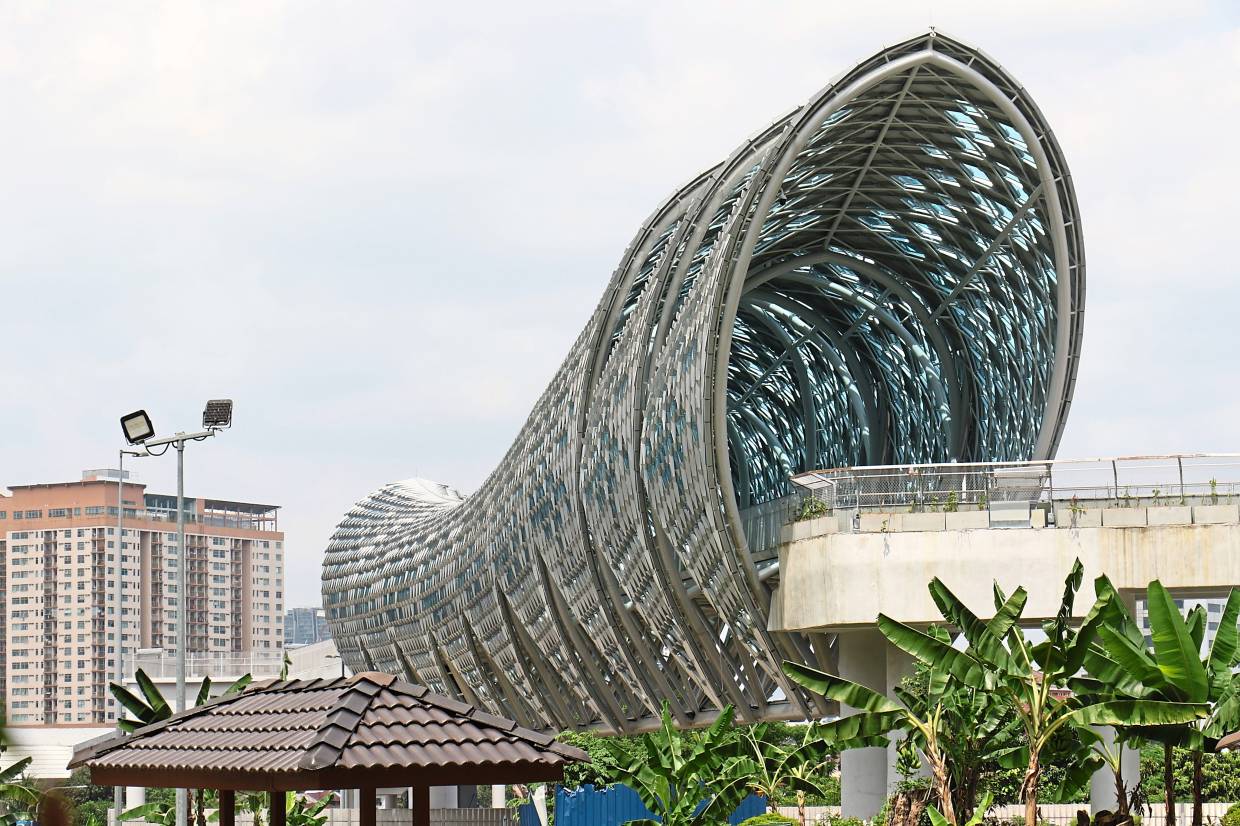
Artwork: The Saloma Link will easily be the country’s most iconic pedestrian bridge, with a design that combines aesthetic appeal with natural ventilation and lighting.
KUALA LUMPUR: Walkability in the city will get a huge boost when the Saloma Link, a new pedestrian bridge, opens at 2.30pm today.
The link offers a seamless connection between Kampung Baru and Jalan Ampang, at a spot near KLCC.
The link was commissioned by the Kampung Bharu Development Corporation (PKB).
Kampung Baru and the KLCC area are separated by the Klang river, and the six-lane Ampang-Kuala Lumpur Elevated Highway (Akleh).
The link offers a seamless connection between Kampung Baru and Jalan Ampang, at a spot near KLCC.
Kampung Baru and the KLCC area are separated by the Klang river, and the six-lane Ampang-Kuala Lumpur Elevated Highway (Akleh).
With the Saloma Link, there is now seamless pedestrian connectivity between the old and new parts of Kuala Lumpur.
In an earlier interview with Bernama, PKB chief executive officer Zulkurnain Hassan said the Saloma Link stretches for 370m, but the span that crosses the highway and river is 69m long.
Though not exceptionally long by modern standards, construction of the steel bridge faced many technical and logistical challenges, as it has to cross an expressway, which has to be kept open.
The two piers of the bridge are also sunk within the protection zones of the Kelana Jaya LRT line tunnels, which rules out the use of heavy machinery, while requiring excavation by hand to minimise vibrations.
Other obstructions that had to be overcome include the water pipes along Akleh, the vehicular tunnel from Akleh to KLCC, as well as LRT tunnel ventilation shaft.
Built at a cost of RM31mil (including consultancy costs), the link starts from Lorong Raja Muda Musa 3, about 100m from the underground Kampung Baru LRT station, and is connected with Lorong Saloma, besides Menara Public Bank on the Jalan Ampang side.
Construction of the walkway took about 18 months.
The bridge’s architecture is inspired by the sireh junjung (betel nut leaf arrangement) concept, which is an integral part of a Malay wedding.
“The sireh junjung is among many other Malay-centric design ideas that we proposed to the
client,” said Azril Amir Jaafar, principal at the Veritas Design Group, the company that is not only involved in designing the aesthetics of Saloma Link, but is also extensively involved in the master plan for the Kampung Baru redevelopment.
The Saloma Link is an integral part of making the city more walkable.
“On foot, it normally takes more than 30 minutes to get from KLCC to Kampung Baru, and across several busy roads.
“With the bridge, it will take pedestrians about seven minutes to get from Jalan Saloma to Jalan Raja Muda Musa 3,” said Zulkurnain.
The Saloma Link is probably the only facility that has a purpose-built slot along the stairways to facilitate those pushing their bicycles as they walk up the stairs on the Kampung Baru side, in addition to a lift.
Over at Jalan Ampang side, a smooth ramp promises universal access to all.
But the bridge will not be open round-the-clock to prevent vandalism.
PKB is likely to follow the operating hours of the Kelana Jaya LRT, which ends near midnight. - Star
In an earlier interview with Bernama, PKB chief executive officer Zulkurnain Hassan said the Saloma Link stretches for 370m, but the span that crosses the highway and river is 69m long.
Though not exceptionally long by modern standards, construction of the steel bridge faced many technical and logistical challenges, as it has to cross an expressway, which has to be kept open.
The two piers of the bridge are also sunk within the protection zones of the Kelana Jaya LRT line tunnels, which rules out the use of heavy machinery, while requiring excavation by hand to minimise vibrations.
Other obstructions that had to be overcome include the water pipes along Akleh, the vehicular tunnel from Akleh to KLCC, as well as LRT tunnel ventilation shaft.
Built at a cost of RM31mil (including consultancy costs), the link starts from Lorong Raja Muda Musa 3, about 100m from the underground Kampung Baru LRT station, and is connected with Lorong Saloma, besides Menara Public Bank on the Jalan Ampang side.
Construction of the walkway took about 18 months.
The bridge’s architecture is inspired by the sireh junjung (betel nut leaf arrangement) concept, which is an integral part of a Malay wedding.
“The sireh junjung is among many other Malay-centric design ideas that we proposed to the
client,” said Azril Amir Jaafar, principal at the Veritas Design Group, the company that is not only involved in designing the aesthetics of Saloma Link, but is also extensively involved in the master plan for the Kampung Baru redevelopment.
The Saloma Link is an integral part of making the city more walkable.
“On foot, it normally takes more than 30 minutes to get from KLCC to Kampung Baru, and across several busy roads.
“With the bridge, it will take pedestrians about seven minutes to get from Jalan Saloma to Jalan Raja Muda Musa 3,” said Zulkurnain.
The Saloma Link is probably the only facility that has a purpose-built slot along the stairways to facilitate those pushing their bicycles as they walk up the stairs on the Kampung Baru side, in addition to a lift.
Over at Jalan Ampang side, a smooth ramp promises universal access to all.
But the bridge will not be open round-the-clock to prevent vandalism.
PKB is likely to follow the operating hours of the Kelana Jaya LRT, which ends near midnight. - Star


No comments:
Post a Comment
Note: Only a member of this blog may post a comment.